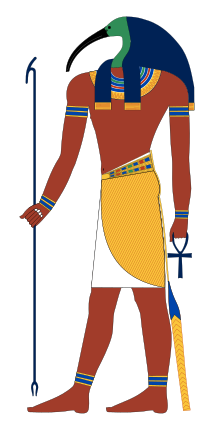Thoth
| ḏḥwty Thoth | |
|---|---|
 Thoth, fel dyn pen ibis | |
| Canolfan gwlt bwysig | Hermopolis |
| Symbolau | Ibis, disg y lleuad, sgrôl papurfrwyn, ysgrifbinnau cyrs, palet ysgrifennu, stylus, babŵn, gloriannau |
| Cymar | Seshat,[1] Ma'at, Nehemtawy[2] |
| Rhieni | Neb (creodd ef ei hun); fel arall Neith neu Ra neu Horws ac Hathor |
| Plant | Seshat yn ôl ambell ffynhonnell |
Duw o'r Hen Aifft yw Thoth (o'r Roeg Θώθ thṓth; sy'n dod o'r Aiffteg ḏḥw.ty). Yn y celfyddydau, gwelir ef fel arfer yn ddyn gyda phen ibis neu fabŵn, anifeiliaid sy'n sanctaidd iddo. Seshat oedd ei wrthran fenywaidd, a Maat oedd ei wraig.[3]
Lleolwyd prif deml Thoth yn ninas Khmun,[4][5] a alwyd yn Hermopolis Magna yn ystod cyfnod y Groeg-Rufeinig[6] (roeddent yn ei gysylltu â'u duw nhw, Hermes) a ϣⲙⲟⲩⲛⲉⲓⲛ Shmounein yn y Gopteg. Dinistriwyd Khmun yn rhannol ym 1826.[7] Yn y ddinas honno, Thoth oedd arweinydd yr Ogdoad, wyth duw pwysig a gafodd eu haddoli yn Hermopolis. Roedd hefyd ganddo nifer o gysegrfeydd yn ninasoedd Abydos, Hesert, Urit, Per-Ab, Rekhui, Ta-ur, Sep, Hat, Pselket, Talmsis, Antcha-Mutet, Bah, Amen-heri-ab, a Ta-kens.
Roedd Thoth yn chwarae llawer o rolau pwysig ac amlwg ym Mytholeg yr Aifft, megis cynnal y bydysawd, a bod yn un o ddau dduw ( Maat oedd y llall) a oedd yn sefyll ar naill ochr cwch Ra.[8] Yn hwyrach yn hanes yr Hen Aifft, daeth Thoth yn gysylltiedig â chyflafareddu rhwng duwiau,[9] hudoliaeth, y system o ysgrifennu, datblygu gwyddoniaeth,[10] a beirniadu'r meirw.[11]
Cyfeiriadau
[golygu | golygu cod]- ↑ Wilkison, Richard H. (2003). The Complete Gods and Goddesses of Ancient Egypt, p. 166
- ↑ Bleeker, C. J. (1973). Hathor and Thoth: Two Key Figures of the Ancient Egyptian Religion, pp. 121–123
- ↑ Eric H Cline, David O'Connor, Thutmose III: A New Biography (University of Michigan Press, 2006), t.127
- ↑ Peidier â'i chymysgu â'r duw o'r enw Khnum.
- ↑ National Geographic Society: Egypt's Nile Valley Supplement Map. (Cynhyrchwyd gan Cartographic Division)
- ↑ National Geographic Society: Egypt's Nile Valley Supplement Map: Western Desert portion. (Cynhyrchwyd gan Cartographic Division)
- ↑ Miroslav Verner, Temple of the World: Sanctuaries, Cults, and Mysteries of Ancient Egypt (2013) 149
- ↑ Budge, The Gods of the Egyptians, cyf.1, t.400
- ↑ Budge, The Gods of the Egyptians, cyf.1, t.405
- ↑ Budge, The Gods of the Egyptians, cyf.1, t.414
- ↑ Budge, The Gods of the Egyptians, cyf.1, t.403
Llyfryddiaeth
[golygu | golygu cod]- E. A. Wallis Budge, Egyptian Religion (Kessinger Publishing, 1900)
- E. A. Wallis Budge, The Gods of the Egyptians, cyf.1 (1904)
- Patrick Boylan, Thoth, the Hermes of Egypt: A Study of Some Aspects of Theological Thought in Ancient Egypt (Llundain: Oxford University Press, 1922)
- Aleister Crowley, The Book of Thoth (1944)
- Claas Jouco Bleeker, Hathor and Thoth: Two Key Figures of the Ancient Egyptian Religion, Studies in the History of Religions 26 (Leiden: E. J. Brill, 1973)
- Jaroslav Černý, "Thoth as Creator of Languages", Journal of Egyptian Archæology 34 (1948):121–122.
- Garth Fowden, The Egyptian Hermes: A Historical Approach to the Late Mind (Caergrawnt: Cambridge University Press, 1986)
- Mark Collier a Bill Manley, How to Read Egyptian Hieroglyphs: Revised Edition (Berkeley: [niversity of California Press, 1998)

